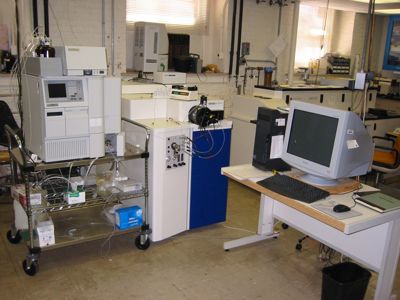
The Q-Tof is a hybrid quadrupole time of flight mass spectrometer with MS/MS capability. The quadrupole is operated as an ion guide in MS mode and as mass selection device in MS/MS mode. A reflectron time-of-flight (TOF) analyzer is placed orthogonally to the quadrupole and serves as a mass resolving device for both MS and MS/MS modes. A collision cell is located between the quadrupole and the TOF analyzer to induce fragmentation in MS/MS experiments. The final detector is a microchannel plate with high sensitivity. The instrument is controlled from a PC using MassLynx software.
The ESI interface consists of an electrospray probe and a Z-spray source. Sample introduction is through an infusion pump, loop injection, or from an HPLC column. A nanoflow electrospray interface is also available for analysis of very small amounts of sample. A capillary LC coupled to the nanoflow electrospray source is an option for analysis of very complex and small-sized samples, such as an in-gel tryptic digest of a protein from a silver-stained SDS-PAGE gel.
The Q-Tof has very high sensitivity, resolution and mass accuracy. The high resolving power (10,000 FWHM) enables improved mass measurement accuracy for peptides, charge state identification of multiply charged ions, and greater differentiation of isobaric species. The high mass measurement accuracy allows exact mass measurements of small molecules and de novo peptide sequencing from MS-MS spectra. When equipped with a nanospray source, the Q-Tof can analyze small sample sizes and identify proteins through semi- and complete de novo sequencing. Peptides derived from tryptic digest of proteins are particularly suitable for sequencing by the Q-Tof, largely because of the size of these peptides (often between 800 and 2500 Da) and because these peptides contain the basic amino acids lysine or arginine at their C-termini. However, the isobaric amino acids leucine and isoleucine cannot be distinguished by this method of peptide sequencing.
For protein identification, the masses of the peptides are used to search public genomic databases to identify the proteins. If a protein cannot be identified in this way, the sequence of one or more of these peptides, determined by Q-Tof mass spectrometry, can be used to search genomic databases for an exact match. In the case of a novel protein, which is not contained within these databases, the de novo peptide sequence can be used for a BLAST (Basic Local Alignment Search Tool) search. This may identify a similar protein from another species, whose sequence can be found in a database. Alternatively, de novo sequencing can be used for cloning experiments to design PCR primers to screen cDNA libraries for clones containing the novel gene.
Typical applications for the Q-Tof mass spectrometer include: peptide (MW =< ~2500 Da) sequencing; protein post-translational modification studies, e.g. glycopeptide mapping or phosphopeptide mapping; exact mass of organic compounds (MW < ~2000 Da); oligonucleotide sequencing; oligosaccharide sequencing; protein-ligand non-covalently bound complexes, e.g. protein-protein, protein-peptide, or protein-RNA; protein folding studies, e.g. H/D exchange reaction monitoring or charge state distribution analysis; and reaction monitoring, e.g. protein modification, disulphide bridge calculation, or enzyme reactions.
The Q-Tof is the primary instrument for HR ESI.